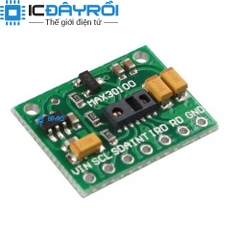Cảm biến nhịp tim và oxy trong máu MAX30102
47.000₫
The MAX30102 is an integrated pulse oximeter and heart rate monitor bio sensor module. It integrates a red LED and an infrared LED, photo detector, optical components, and low-noise electronic circuitry with ambient light suppression.
- The MAX30102 features a 1.8V power supply and a separate 5.0V power supply for internal LEDs for heart rate and blood oxygen acquisition in wearable devices, worn on the fingers, earlobe, and wrist. The standard I2C-compatible communication interface can transmit the collected values to the Arduino, KL25Z and other micro controllers for heart rate and blood oxygen calculation.
- In addition, the chip can also shut down the module through software, the standby current is close to zero, and the power supply is always maintained. Because of its excellent performance, the chip is widely used in the Samsung Galaxy S series mobile phones.
- Compared with the previous generation MAX30100, the chip integrates a glass cover to effectively eliminate external and internal light interference, and has the best reliable performance.
The Main Parameters:
LED peak wavelength: 660nm/880nm
LED power supply voltage: 3.3~5V
Detection signal type: light reflection signal (PPG)
Output signal interface : I2C interface
Communication interface voltage: 1.8~3.3V~5V (optional)
Board reserved assembly hole size: 0.5 x 8.5mm
Pin Description:
VIN: main power input terminal 1.8-5V
3-bit pad: Select the pull-up level of the bus, depending on the pin master voltage, select 1.8v or 3_3v (this terminal contains 3.3V and above)
SCL: the clock connected to the I2C bus;
SDA: data connected to the I2C bus;
INT : Interrupt pin of the MAX30102 chip;
RD: RED LED ground terminal of MAX30102 chip, generally not connected;
IRD: The IR LED ground of the MAX30102 chip is generally not connected;
GND: Ground wire.
Principle Description:
- Light-dissolving method: measuring the pulse and blood oxygen saturation by using human tissue to cause different transmittance when the blood vessel beats;
- Light source: a specific wavelength of light-emitting diode selective for oxyhemoglobin (H bO 2 ) and hemoglobin ( Hb ) in arterial blood;
- The transmittance is converted into an electrical signal: the change in the volume of the arterial pulsation causes a change in the transmittance of the light. At this time, the photoelectric variator receives the reflected light from the human tissue, converts it into an electrical signal, and amplifies and outputs it.

















